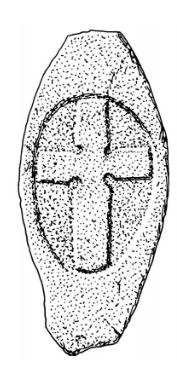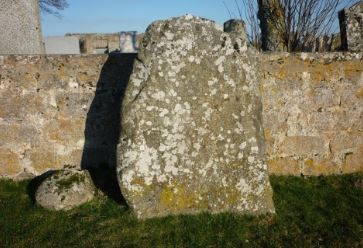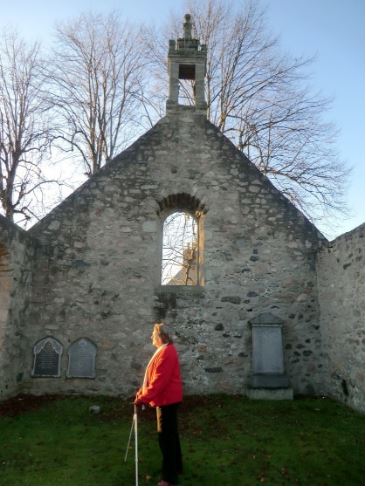Article 4 - Logie Coldstone and Tarland
Article 4 - Logie Coldstone and Tarland
St Nectan, Coldstone Grid Ref NJ 422056
St Wallach,Logie Grid ref NJ 437024
St Moluag’s Church Tarland Grid Ref NJ 482044
What we now know as Logie Coldstone is one village with one church built in the 19th century. From time immemorial however there were two villages or settlements, and each one had a church. On the hillside off the road from modern day Logie Coldstone to Tilliepronie lies the churchyard of the former church of Coldstone dedicated to St Nectan, and in that yard is the carved cross slab illustrated above both by a drawing and a site photograph. This cross is quite different from the Pictish crosses at Aboyne , Migvie, and Loch Kinord, and much more like St Ternan’s Cross at Banchory and can probably be dated to the 8th or 9th century.

This kirk yard once contained a church dedicated to St Nectan , but we do not really know who this St Nectan was. Nectan spelt in various different ways was a common Pictish name. There were three Pictish kings between the 5th and the 8th centuries, a Bishop of Aberdeen in the 12th century and Saint Nectan of Hartland associated with Devon and Cornwall in the 5/6th centuries. The only saint among these, St Nectan of Hartland, does not appear to have any connection with Aberdeenshire so we are left wondering why the church came to be dedicated to him. I noted in my article on St Nathallan of Tullich that modern scholarship links the name Nathallan with Nectan. This may be a clue . At all events, all sources now agree that the church was dedicated to St Nectan, or as the Aberdeen Sites and Monuments Record spell him, St Neachton, and that seems to be all that can be said about this mysterious saint.


We are only slightly more enlightened by the records of St Wallach. About 2 km south of modern Logie Coldstone , near the farm of Galton at the above Grid Ref, lies the graveyard of Logie. Many people including writers are confused by the fact that there are two graveyards, at Logie and at Coldstone, and there is also a church but no graveyard at Logie Coldstone. Although the Aberdeen Breviary dates Wallach to the 5th century, other authorities place his death in 733. The Breviary tells us a little about his lifestyle, but more about the Picts of his day:- “He preferred a poor little house, woven together of reeds and wattles, to a royal palace. In this he led a life of poverty and humility, on all sides shunning the dignities of the world, that he might achieve to himself a higher reward in heaven. But the race whom he preferred to convert to the faith of Christ, and whom actually by his preaching and exhortation he did convert, no one would hesitate to describe as fierce, untamed, void of decency of manners and virtue, and incapable of easily listening to the word of truth, and their conversation was rather that of the brutes that perish than of men.”
The stone at Logie, named “St Wolack’s Stone” on the OS map, is really the only evidence of his activities here if it is even that. There is more evidence on the ground in the Parish of Glass where there was a Walla Kirk (Wallach’s Church) and St Wallach’s Well nearby on the banks of the Deveron. His feast day is 29th January but it is not much remembered now.
We know more about the life of St Moluag than we do about why the pre Reformation church at the east end of the Square in Tarland was dedicated to the saint. Tarland was always a centre of population in Cromar. The recumbent stone circle at Tomnaverie, less than a mile to the south east and the settlement and field system to the South west are ample evidence of pre Christian occupation. We have already seen that the Howe of Cromar was an area of intense activity by the followers of St Nathallan, St Nidan, St Adomnan, St Nechtan and St Wallack who left us the Migvie Stone, the Formaston stone, the stone at Coldstone and the Kinord stone, but we have no evidence that St Moluag ever came to the area. And yet the original church in the village was dedicated to St Moluag. So who was St Moluag?
By tradition he was born the son of a Pictish nobleman in Ireland c 532 and educated at Bangor. He is said to have come to Scotland with St Columba, and while Columba undertook to evangelise the Gaelic speaking areas, Moluag took on the Pictish areas. He is credited with founding a monastery on the Isle of Lismore, and two other centres in the land of the Picts, at Rosemarkie and Mortlach. It is significant that these three sites were to become the seats of the Sees of The Isles, Ross, and Aberdeen. As well as St Moluag’s Cathedral in Lismore, there are many churches in the west which have his dedication, and in Aberdeenshire there are dedications at Clatt and at Tarland where there was a Luoch Fair , believed to be named after Moluag. Which brings up the question of his name. When dealing with St Kentigern and St Machar, I touched on the custom of the age to add the affectionate prefix Mo- (My) to the name of a loved one. There are those who think that his real name was Lugaidh (pronounced Lua) and that the writers of the Annals simply added Mo- to give Mo-lugaidh and hence Moluag. At all events, he is credited with the foundation of the above three important centres in Pictland, and over time this made him a very important Saint indeed. Other writers credit him with foundations at Clova and New Machar, as well as at Clatt, and Tarland, but there is no word of anything but a church in Tarland, and it seems to me that it is just as likely that the church there was founded by someone else, and was dedicated to Moluag at a later date when his importance as a saint was fully acknowledged.(Right – Bev in the pre Reformation St Moluags Church ruin showing the post Reformation belfry)
© Hugh Cochran 2012

Discover more…
